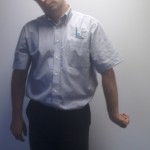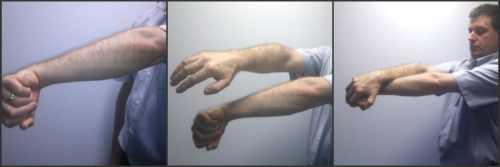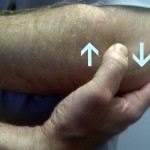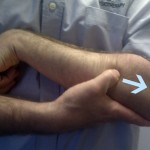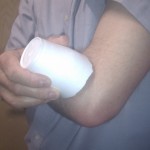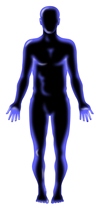Lateral Elbow Pain (Tennis Elbow)
Tennis Elbow is caused by over use of the wrist extensor muscles and overloading at the site where they attach at the elbow. Symptoms can include pain on the outside of the elbow and tension in the forearm and can be aggravated by simple actions such as shaking hands with someone or opening a door and any gripping action.
The condition can be triggered by many different activities but most commonly a repetitive action such as playing a racquet sport with increased intensity or an occupational factor, e.g. computer work or manual work.
Pain usually develops gradually. Initially, it may be only be painful following exercise. These symptoms are usually ignored as they disappear quickly. However, as you continue exercise, the problem progresses and the pain within the tendon becomes more frequent and intense.
This pain may initially disappear as you warm-up, only to return when you cool down. As you continue to exercise further, the problem worsens and the pain may begin to be present for longer periods during exercises until it is present all of the time.
Treatment should be directed towards stopping or at least modifying the activity that has caused the problem in the first place.
If tennis is the culprit, and it very often isn’t, then you should stop or at least only practice the shots that do not cause any pain both during or afterwards. There are many variables can cause the onset of symptoms; change in racket, change in string tension, grip size, increased intensity of playing, change in technique, wet tennis balls. It may also be caused by variables out with tennis such as DIY (hammering, drilling) excessive mouse use and heavy lifting. These activities may also aggravate the symptoms and should therefore also be modified.
Various taping and braces can be used which allow the wearer to perform more activity but these don’t necessarily get to the bottom of the problem.
If the pain is acute or there is swelling and/or heat at the elbow then ice (be very careful as ice can burn) can be used to settle the pain down. Icing should consist of ice pack wrapped in a moist towel and applied for 15-20 minutes or Ice Cup Massage over the outside of the elbow for 2 -3 minutes.
Anti-inflammatories can be useful in the short term. Often tennis elbow is more chronic in nature and treatments such as trigger point therapy to the local soft-tissues, stretching of the appropriate muscles, neural mobilisation and progressive strengthening of the appropriate muscles needs to be undertaken.
Pain in your elbow can come from other sources such as your neck, local nerves and local ligaments. These will require other interventions.
We have illustrated some tennis elbow exercises/ stretches below that you may find useful.
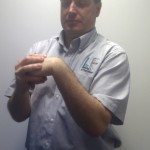 Wrist Extensor Muscle Stretch (Left)
Wrist Extensor Muscle Stretch (Left)
- Gently bend the wrist forward (fingers relaxed)
- Add gentle pressure with the other hand
- Hold for 30 s and repeat 3 times.
- You should experience tension only and no pain
- Make a gentle fist
- Turn arm inwards
- Pull wrist up
- Squeeze shoulder down
- Gently take head over to the right
- Gentle tension only
- Hold 5s and repeat 5 times
- Gentle tension only. No pain or tingling
Wrist Extensor stretch in Elbow Extension (Left)
- Make a gentle fist
- Flex wrist
- Straighten arm and turn arm inwards
- Place your right hand over the top of the left and apply gentle pressure on the left hand towards your body
- Hold for 30 s and repeat 3 times
Transverse Frictions
- Move your thumb backward and forwards over the sore area
- This helps stimulate blood supply and tissue mobility
- This should only be uncomfortable and not painful
- Repeat for 3 -5 minutes stopping if the area gets too painful
- Use some moisturiser on your skin to allow comfortable movement with minimal friction on skin or hairs
- Bend the left wrist to tighten soft-tissue
- Push your thumb into the tissue and glide towards your elbow
- Repeat 10-15 times
- Massage the ice cup around the sore area for 2 – 3 minutes
- You must keep the ice cup moving at all times as ice can burn
- If you get any pain or tingling stop the ice cup massage
- The area should be numb after a couple of minutes
Disclaimer: This information is not a substitute for medical advice and you seek professional advice from a doctor, physiotherapist or other healthcare professional.
